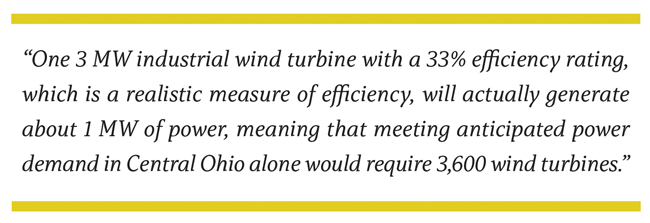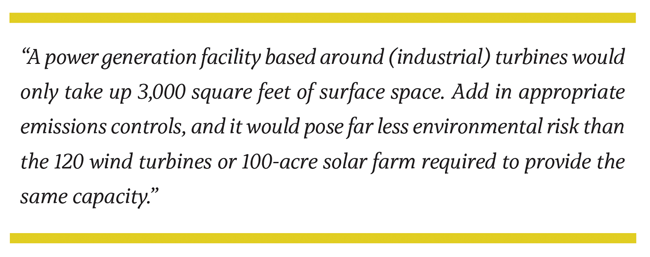
Oil Field Microgrids Will Help Meet Growing Electricity Demand
By Lyoid Fussell
Everyone involved with electric fracturing operations knows all too well that power solutions are becoming scarce. While reciprocating engines have been widely used, natural gas turbines continue to grow in popularity thanks to their power density and therefore smaller footprint on location, as well as their reliability and reduced maintenance requirements.
However, the supply of turbine-based mobile gensets is almost completely deployed. While there are some new gensets in the pipeline, the limited supply of aeroderivative turbines caps that number at a level too small to provide significant relief. In response, the industry is beginning to consider smaller turbine packages, such as Solar Mobile Turbomachinery’s SMT130 16-megawatt generator system and SMT-60 6 MW units, as well as JT-6 6 MW systems. Generally, a frac spread with around 40,000 hydraulic horsepower can be powered with seven 6 MW turbines or two 16 MW turbines.
To secure these turbines, electric fleets must compete with other end users. In addition to their oil field roles, mobile turbines support power grids when normal capacity must be taken off line for maintenance or during periods of unusually high demand. More recently, with the vast and rapid growth of data center and AI facilities, turbines have been allocated to get projects up and running when the grid is not yet ready to supply them. This approach prevents long delays before the facilities can start operations.
Returning to the oil sector, mobile turbines also help satisfy the needs of pipeline compressor stations and of oil fields that are on the fringe of the main power grid and need reliable power for electric submersible pumps. These fields of late have suffered from inconsistent power and brownouts.
The demand for power already is beginning to exceed supply. That situation must be addressed if the United States is to remain at the forefront of technological advancement.
Alternatives’ Limitations
Alternative power is not a viable solution. Ohio illustrates how impractical it can be. In June, American Electric Power Ohio noted that data centers have pushed its wait list for power in Central Ohio to almost 36 gigawatts.
One 3 MW industrial wind turbine with a 33% efficiency rating, which is a realistic measure of efficiency, will actually generate about 1 MW of power, meaning that meeting anticipated power demand in Central Ohio alone would require 3,600 wind turbines. For context, some estimates put the United States’ total wind turbine count around 92,000. Adding 3,600 would represent a 4% increase.
One acre of solar panels produces about 1.2 MW, so the state would need 30,000 acres of solar panels to clear Central Ohio’s current wait list.
A Real Solution
At this point, many companies are scrambling for answers to this power deficit. And the answer is one of the United States’ most abundant resources: natural gas. With proper planning and strategy companies can tap the solution right under their feet. In the past, the United States generally has expanded power capacity by building massive power plants and distributing their output across the grid. Today, regulators and the traditional grid cannot move fast enough to keep pace with demand.
By building independent microgrids to turn natural gas into local power, oil and gas producers could play a critical role in addressing power demand. As they transform into energy companies capable of directly supplying data centers and other emerging power consumers, these producers will generate extra revenue that is insulated from shifts in oil and gas prices. This should help them maintain activity, retain employees and secure access to services throughout commodity price cycles.
What exactly am I proposing? I am suggesting that operators with substantial acreage positions consider the advantages of incorporating power plants into their development plans. This would likely involve laying out independent infrastructure, complete with power lines, transformers, load shedding software and substations that are disconnected from the grid.
The power stations can be sized based on reservoir estimates. Once they have calculated their power production ability, operators could secure commitments from technology partners that are facing a power drought limiting their ability to expand their data and computational facilities. Access to power could entice data centers to move away from metropolitan hubs to rural areas, bringing jobs and economic development to some of our most underserviced communities.
Other Benefits
Regarding the environment, how could anyone oppose oil field microgrids? Since power generation facilities in this scenario can be stationary, it is possible to implement several emission reduction technologies that are impractical on mobile generators. These include cogeneration and selective catalytic reduction systems that reduce emissions for particulate matter and oxides of nitrogen to near zero.
Industrial turbines are in much greater available supply than aeroderivative turbines. The largest industrial turbines can generate 600 MW, but that would be excessive for this application. The ideal sizes range from 40 MW to 120 MW.
A power generation facility based around such turbines would only take up 3,000 square feet of surface space. Add in appropriate emissions controls, and it would pose far less environmental risk than the 120 wind turbines or 100-acre solar farm required to provide the same capacity.
Because they are powered by locally produced natural gas, these microgrids would be completely self-sufficient and independent from the primary grid. However, if the primary grid gets into a bind during emergencies or unforeseen outages, the microgrids could act as a supplemental safety net that enhances national security.
It is only a matter of time, and in my opinion not much time, before microgrids begin to spring up around the country. The United States of America is too resilient to allow a solvable problem to hold us back. As demand for power continues to grow, producers that want reliable access to power and a more diverse revenue stream likely will invest in rural microgrids. In the process, they will boost local economies and enable the United States to continue redefining what technology can achieve.

LYOID FUSSELL is the co-founder of FW Consulting Power Solutions, which helps identify and secure power generation solutions for projects that convert natural gas to electricity. Fussell has more than two decades of industry experience, previously serving in management and sales roles at Trisun Energy Services, ResMetrics, EcoStim Energy Solutions, Ely and Associates Corp., PetroQuest Energy, Core Laboratories and Halliburton. A U.S. Army veteran, Fussell holds a B.S. in industrial engineering from Kansas State University.
For other great articles about exploration, drilling, completions and production, subscribe to The American Oil & Gas Reporter and bookmark www.aogr.com.
















